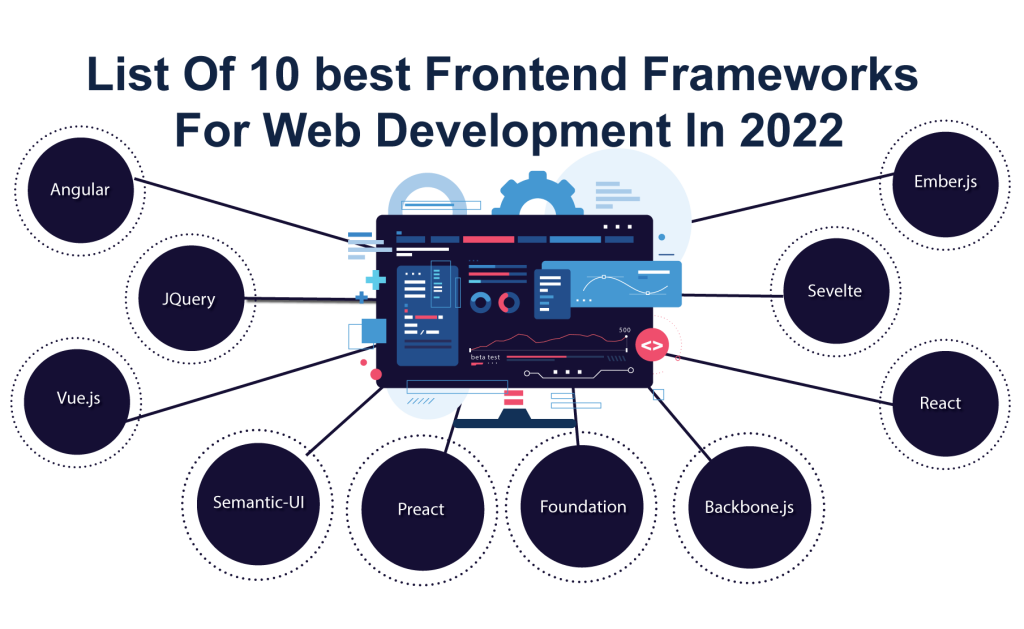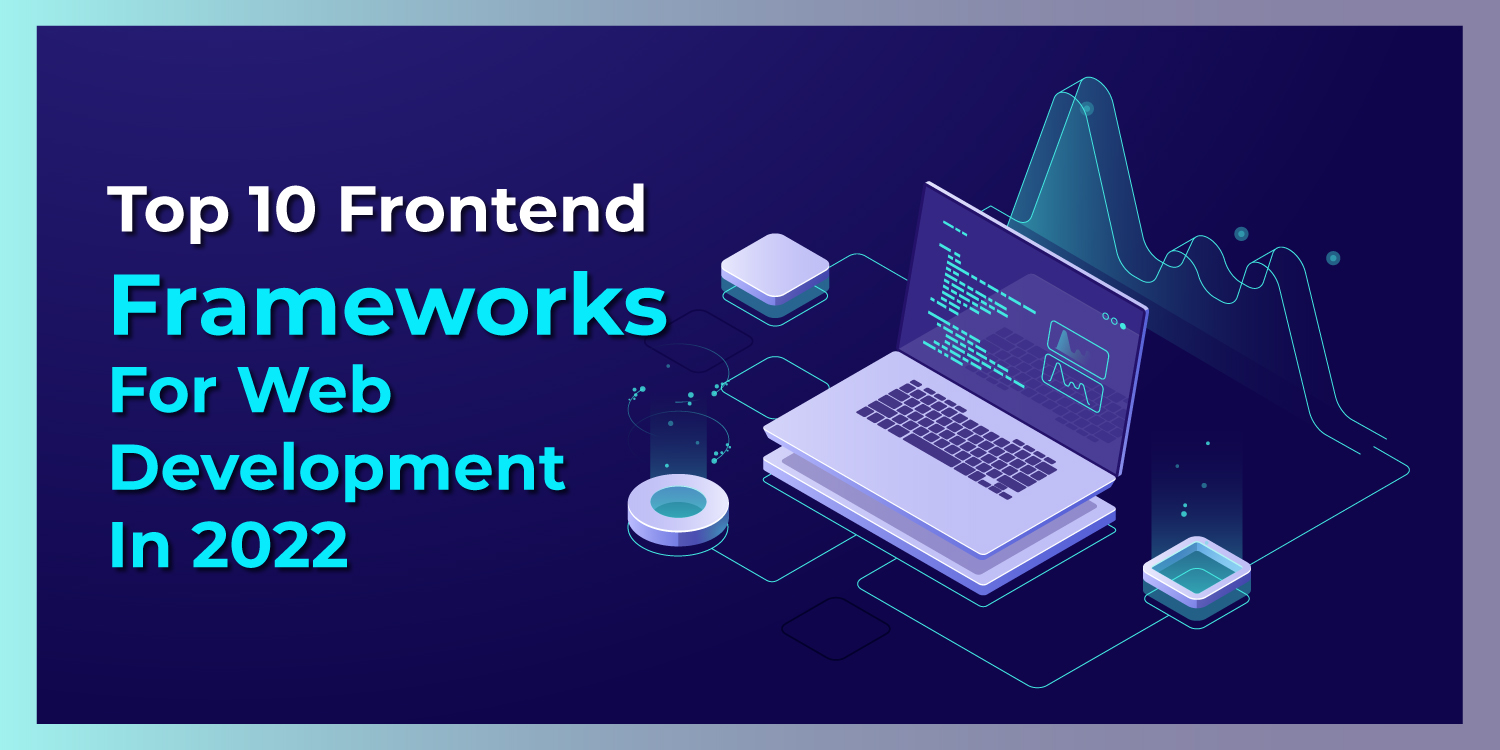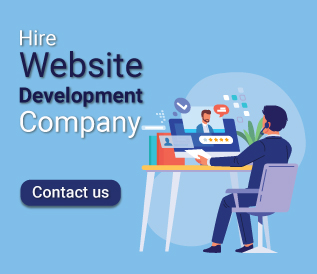In today’s web development, the requirements which remain on the top priority for any business are exceptional user experience and faster time to market. Using frontend development frameworks significantly one can simply achieve these goals. But the market is flooded with frontend frameworks and choosing the best one can be a confusing task for business owners.
To help them out, we have compiled a list of highly popular frontend frameworks for web development along with their pros and cons. Considering which one can easily choose the best companion for their web development project.
Table of Contents
ToggleWhat are Frontend Frameworks?
Before scrutinizing the list of top 10 frontend development frameworks, let’s understand the term in question first, frontend framework. To simplify the definition of the frontend framework, we will separately elaborate on both the terms and then reach a conclusion.
Frontend: in web development, the frontend can be understood as the graphical user interface of a website or an application. For a more simplified version, the frontend is the visible part users interact with. It should be user-friendly and competent to showcase information efficiently from the backend.
Framework: on the other hand, is a software product that handles the development and maintenance of complex projects. It includes software modules along with the ready-to-use pieces of code to solve several programming tasks like managing AJAX requests or defining file structure. Not only this, they govern the rules for building app architecture. Also, the programmers get availed with the skeleton that can be extended or modified as per the specific project requirements.
In addition to this, frameworks can be a collection of utility programs, code libraries, scripting languages, and other software that support the development and integration of various components of a large software product.
Thanks to frameworks, developers don’t have to start the project from scratch. They get the foundation and make necessary project-specific additions to it. This results in saving valuable time and pacifying the development process.
Frontend Framework: Cumulatively, a frontend framework can be understood as a software product/tool/platform that supports the development of the frontend parts of web solutions.
Types of Solutions You Can Create with Frontend Frameworks
As everyone knows the market is flooded with frontend frameworks, each of them will be competent to create completely different solutions whether in terms of scale and purpose.
For your information, frontend development frameworks are capable of creating solutions that are operated in a web browser. Likewise, websites, web applications, web services, or mobile apps.

List of 10 best Frontend Frameworks for Web Development in 2022
1. Angular
Angular is one of the most popular front-end development frameworks in 2022. It is based on TypeScript and was initially released via Google in 2016 to bridge the gap between the increasing technological demands and conventional notions that displayed the results.
Angular facilitates the two-data binding that makes it an exclusive framework with quality. Wherein a real-time synchronization between view and model takes place that provides an instant view of any alteration done in the model on view and vice-versa.
If you are willing to develop web or mobile apps, Angular is the best choice. Other than this, you can also develop progressive web apps or multi-page applications as well.
Some popular brands like Blender, BMW, Forbes, and Xbox have utilized Angular for the development of their business apps.
Pros
- Large Ecosystem
- High Performance
- Simplified coding procedure owing to it refactoring services and improved navigation
- Its component based pattern enables the development of a user interface with single components
Cons
- Angular complication
- Not properly defined CLI Documentation
- The learning effort
- Relocating legacy schemes from AngularJS to Angular
Use Angular for the development of enterprise-scale solutions with complex structures and a number of features/functionalities. It is the best fit for the creation of progressive web apps or multi-page apps with dynamic content. The framework is best to choose when developers are sound and skilled in using a platform for creating complex web solutions.
Don’t use Angular for small projects utilizing simple syntax and having static content.
2. React
Created by Jordan Walke, a developer at Facebook in 2011, React is a javascript library that is used to build user interfaces and is often called a frontend framework. In 2013, React became available for everyone as an open-source framework and started to get popular in the market.
Popular giants like Netflix, Tesla, PayPal, Walmart, and more have used React for their web development. It simply advocates React popularity and proves its quality and reliability in the market.
Pros
- Easy to learn
- Fast development
- Facebook support
- Large community
Cons
- JSX complexity
- Poor documentation
Use React for building interactive visual layers of single-page web apps and progressive web apps in a limited time period.
Don’t use it if developers are not proficient in working with JavaScript or inexperienced to master JSX.
3. Vue.js
One of the most promising JavaScript frontend frameworks, Vue was initially released in 2015, and its most advanced version is Vue 3. O marked its presence in 2020 after a long wait of five years. However, in its latest version, Vue has fulfilled all the expectations of developers all over the world.
Vue is completely written in TypeScript that greatly supports agile development. Other than this, developers will have small packages, new APIs, and support for Server-Side Rendering (SSR) that create more development opportunities.
Pros
- Detailed documentation
- Easy to learn
- Virtual DOM
- Third-party integrations
- High performance
Cons
- Linguistic challenges
- Small community
Use Vue.js for building small, large-scale web and mobile apps, PWAs, and complex single-page apps.
Don’t use Vue.js for large projects if the developers don’t have enough experience working on this framework since every time you won’t be able to get support from the community and the project will be delayed.
4. JQuery
jQuery is the oldest and one of the most preferred front-end development frameworks. Well, it is a library just like React but owing to some of the characteristics it falls in the category of the framework.
Released in 2006, the jQuery framework is majorly used to optimize the interactivity of user interfaces by manipulating CSS and DOM elements, handling events, animations, AJAX, and other functions.
Some popular tech giants like LinkedIn, Twitter, and Slack have already used jQuery in their products.
Pros
- Simplicity
- Strong community support
- Mobile enablement
- Browser agnostic
Cons
- Outdated APIs
- Slow performance
Use jQuery for the creation of simple yet lightweight and dynamic applications
Don’t use jQuery for the development of large-scale web solutions as you have to write tons of extra code lines.
5. Ember.js
The Ember.js frontend framework was launched in the market in 2011. Since then the platform is being used to build scalable cross-platform apps. Well, a limited number of developers use this framework as it is hard to learn and a heavy framework.
Pros
- Well-written documentation
- Command Line Interface
- Built-in router
- Reusability
- Ember Inspector
- Two-way data binding
Cons
- Steep learning curve
- Small community
Use Ember.js for the creation of enterprise-scale web and mobile app projects as the framework provides a complete setup of functionalities to add.
Don’t use Ember.js for small projects as it is a heavy framework.
6. Backbone.js
Initially released in 2010, Backbone is an easy and lightweight framework for a frontend developer. It is based on the Model-View-Presenter (MVP) architecture and aimed at developing single-page apps
Pros
- Free and open-source
- Fast and lightweight
- Easy to learn
- Allows the creation of well-structured applications
Cons
- Dependency on other libraries
- Minimalism
Use Backbone.js for the creation of dynamic applications that require constant synchronization with the server.
Don’t use Backbone.js if you have to create all the functions out-of-the-box and the development team is not prepared for the use of additional extensions and plugins.
7. Svelte
Initially released in 2016, Svelte is a newbie in the frontend development frameworks since its stable release marked its presence in the market in autumn 2021. Still, Svelte is getting undue attention from developers across the world owing to its fundamentally new approach to UI development.
Like other frameworks, Svelte does not perform its main work in the browser else in the compiler at the build stage; that’s why there is no need for virtual DOM, and the components that need to display the app can be uploaded to the page.
Pros
- Good for beginners
- Clear syntax
- Faster applications
- Stability and high-performance
Cons
- Not mature enough
Use Svelte if you want to develop a small and fast application with the support of a small team of developers including beginners as well.
Don’t use Svelte if you want to create large enterprise-scale applications as the framework is not mature enough and you will find it hard to get support from its small community.
8. Semantic-UI
Semantic-UI is one of the most used front-end development frameworks when it comes to the creation of beautiful and responsive websites. The framework is constantly improving, updating its functionality and expanding features. Therefore, it can be considered as a better alternative to Bootstrap.
Pros
- Convenient for designers
- Simple syntax
- Third-party integration ease
- Easy debugging
- Customization ease
- Intuitive user interfaces
- Out-of-the-box functionalities
Cons
- Less popularity
- Complex structure
Use Semantic-UI if you want to create a customizable lightweight design for your web solution’s client-side following a few clicks.
Don’t use Semantic-UI if your team members are not experienced enough to handle customizations without using ready-made functions.
Get A Best Frontend Frameworks For Web Development
We can assist you! Click here to get the 10 best frontend frameworks for web development services in 2022!
Request A Quote9. Preact
Preact can be understood as the advanced version of React as everything comes with its own shortcomings. It is a small-sized framework that offers the same features as React.
Fundamentally Preact and React both share the same API and take the same methodologies into consideration for app development. The only difference between both the frameworks is the size and Preact uses the thinnest and fastest virtual DOM possible.
Pros
- Small in size
- Efficient memory use
- Fast and efficient performance
- Compatibility
- Comprehensibility
Cons
- Lack some features
Use Preact when you want to create a small application without complex integrations competent to perform one function well
Don’t use Preact if you want to incorporate a full spectrum of features into your application.
10. Foundation
Foundation frontend development framework was initially released in 2011, however, its stable release rolled out in the market after a long interval of 9 years in 2020. Based on Sass scripting language, HTML, CSS, and JavaScript, Foundation is a credible alternative to Bootstrap and lets you develop appealing websites, emails, and apps that look great in both browser and mobile devices.
Pros
- A responsive toolkit
- Reusable interface elements
- Immense customization ease
Cons
- Hard to learn
Use Foundation if you want to create visually stunning and mobile-friendly websites with a personalized user experience.
Don’t use Foundation if your developers have less experience working with Foundation and can’t handle customization complexity.
Conclusion
So these are the top 10 frontend frameworks for web development in 2022, which you can consider for your website, web apps, or mobile app projects. Here we have mentioned the pros and cons of all the listed frontend development frameworks along with when to use and when so that you can choose the best fit as per your project-specific requirements. Still, if you are facing difficulties in deciding upon the best frontend framework for your web development project, you can consult our development team. DreamSoft4u is an industry-leading web development company, here you will receive best-in-class development service or IT consulting at a reasonable price tag. Connect now!!











